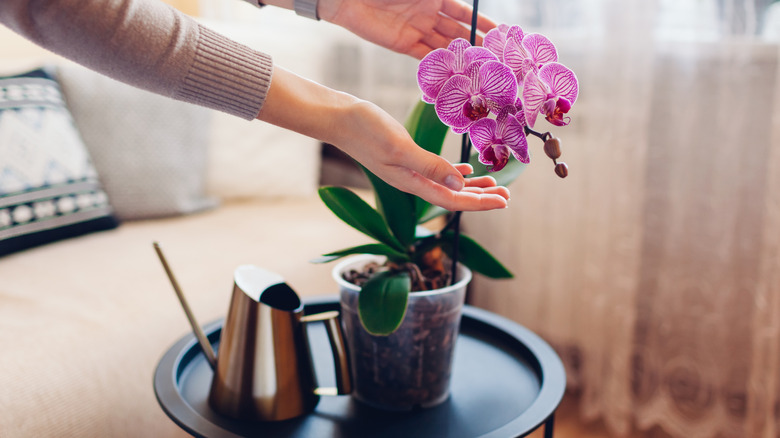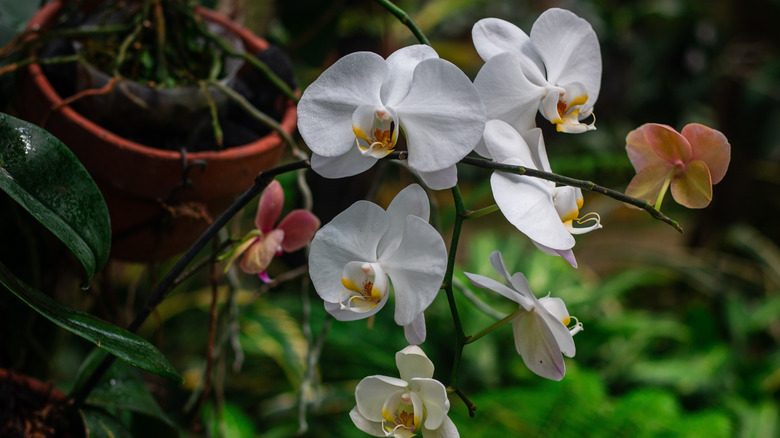Don't Toss Your Dormant Orchid, Watch It Take Off Outdoors Instead
Orchids are exquisite houseplants, with arching stems and delicate flowers that add elegance to any room. However, they have a reputation for being hard to keep alive. Even if you've avoided common mistakes that are sure to kill an orchid and have read up on how to successfully grow orchids indoors, the plant's dormant period can cause even the most confident green thumb to doubt themselves. If your orchid hasn't flowered for at least six months, but still looks green and healthy, it's likely dormant (and still alive). This normal part of an orchid's cycle allows it to rest and conserve its energy to push out blooms come spring and summer.
Before you give up on your dormant orchid, consider moving it outside, where the orchid has a better chance of making a stronger comeback if given the warm, humid conditions that reflect its native tropical habitat. Hardy varieties like Cattleya, Dendrobium, or Cymbidium orchids will do especially well outside. If temperatures in your area get too low to grow the orchid outside year-round, keep it in a pot for easy transport inside and out between seasons. If you live in a warmer climate, try attaching your orchid to a tree (and dazzle your neighbors!). Since orchids are epiphytic in nature, meaning they like to grow on other trees or plants, they can thrive outside of a pot.
Tips for moving an orchid outdoors
One very important note is that orchids can survive outdoors only in certain regions. According to the American Orchid Society, orchids can survive outdoors only south of the 37th parallel — slightly south of San Francisco and spanning east right below Richmond, Virginia. "It can't get cold, so this trick with the tree is only if you live in a tropical place (in which case you may already see wild orchids, e.g., Florida)," said Sam Arthurs, House Digest's expert flower farmer, in an exclusive interview with House Digest. "Everyone else needs to bring it back in before late fall."
The best time to move your orchid outside is during the summer, the prime growing season for more orchids, although a cold-tolerant variety, like Cymbidiums, can move outside sooner. Anytime you transition an orchid from indoors to outdoors, this process will need to be gradual so the plant doesn't go into shock. Even if your variety tolerates full sun, putting a plant in full sun outside is not the same as placing it in a sunny window indoors. Find a spot with filtered light, perhaps under the shade of a large tree or under a brightly lit patio.
The warm outdoor air will likely dry out the potting material more quickly than when the orchid was inside, so monitor your plant closely and water it anytime the soil feels dry. Depending on how much sunlight and heat your plant is getting, this could mean watering it daily or every few days. However, don't forget to avoid these watering mistakes.
Growing an orchid successfully on a tree
For those of you who live in a climate where orchids can stay outside year-round, consider growing your plant on a tree. First, pick a host branch that meets your specific orchid's needs. A shade-loving variety will require a spot close to the tree trunk, shielded from direct sunlight by other branches. Orchids that tolerate sun or enjoy filtered light should sit near the end of a branch, where some sunlight can stream through the leaves.
Use a natural material like jute, burlap, or twine — not metal — to attach the plant to the tree. As the orchid and tree grow, the material needs to either break apart on its own or break down naturally. Position the orchid with its leaves pointing upward and the roots growing downward, with the newest root tips making contact with the tree bark. Secure the orchid to the tree where the stem and roots connect.
Water the orchid more than usual as the plant establishes itself on the tree — as much as daily for the first two weeks and then tapering off in the following weeks. By the fourth week, watering it every three days should be sufficient. After the first month, you can stop watering the orchid, if your region is getting rain. But during the hot sunny weather, daily watering may be necessary. Since orchids absorb moisture through their roots, they will need more water, especially with their roots exposed on the tree. If it survives the transition period to the tree, you should expect beautiful flowers during the blooming season.

